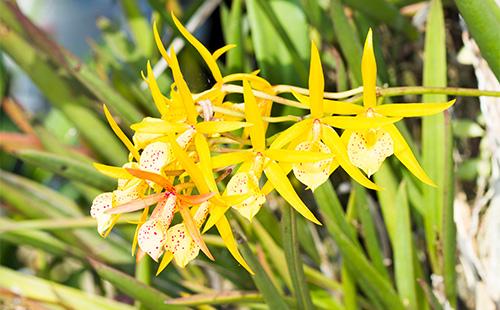The content of the article
Cattleya is a rather difficult orchid to grow. It requires not only constant attention, but also the presence of certain knowledge. Only with proper care in favorable conditions will it be regularly covered with beautiful flowers.
Botanical Description
The genus Cattleya belongs to the orchid family. According to various sources, it has from 40 to 100 varieties. Among them there are epiphytes (grow on trees) and lithophytes (settle on stones), but they all grow in tropical rainforests.
Cattleya grow on a sympodial type. New shoots grow from the base of the previous stem, and the old ones gradually die off - they are replaced. The growth point begins from a rhizome - a modified, thickened stem. Cattleya’s aerial roots are quite thick, but fragile. They are covered with light sponge fabric - velomen. Bulbs are cylindrical or spindle-shaped, elongated.
Cattleya are divided into univalent and double-leafed. In rare cases, there are three-leafed bulbs. The leaves are dense, fleshy, without stalks. The shape is elongated, oval, the color is light green. A slight bend along the main vein is characteristic.
Cattleya orchid begins to bloom only when a certain age is reached. For each particular instance, the readiness for flowering occurs at different times. The main sign of a plant that has matured to form a peduncle is the appearance of a small leathery, flat cover on top of the bulb. After a while, a tall naked peduncle with one to three flowers grows from it. Flowering lasts almost a month. It was for the amazing beauty of the flowers that the cattleya was called the queen of orchids.
Cattleya have zygomorphic flowers (they have only one plane of symmetry). The corolla is formed of three narrow sepals, a pair of wide petals, lips and columns. In turn, the column is formed by a pestle and a column fused with stamens. The lip is three-lobed, the column is long, slightly curved.
Popular views
In addition to natural species, breeders have bred more than 1000 hybrid varieties. Of these, four of the most popular Cattleya species can be distinguished.
- Two-tone. In height, the adult plant does not exceed 60 cm. The flowers are interesting, reddish-brown in color, with a distinct purple lip. A light fringing runs along the edge of the lip. The diameter of the flowers is about 10 cm.
- Bowring. A higher variety is up to 70 cm. The flowers are not large - no more than 7 cm in diameter. The color is purplish pink. A lip of a similar shade, with a bright yellow spot.
- Triana. A plant about half a meter high. The flowers are large - up to 20 cm in diameter. Coloring - white-pink. Against the main background, a raspberry lip with a white border stands out clearly. It blooms in winter or early spring.
- Forbesa. One of the smallest orchids. The height of an adult plant does not exceed 20 cm. The flowers are quite large - about 10 cm in diameter. The coloring is delicate - olive, tinted with a white-pink lip.Flowering occurs in summer or autumn.
Cattleya care and a favorable microclimate
Cattleya is considered quite difficult to grow. When organizing Cattleya orchid care at home, they take into account the usual climate features, try to recreate them in the apartment.
- Lighting. Any kind of orchid needs diffused but bright light. The optimal location in the apartment is the east or west side. Sometimes they put a cattleya on the south window, but provide for shading in the summer. In summer, she feels good on a glazed loggia or balcony. In the afternoon, they open windows, but try to protect the cattleya from unnecessary drafts. Orchid bloom directly depends on the intensity of lighting and the duration of daylight hours. In winter, the use of additional lighting is encouraged.
- Temperature. During active growth and flowering, Cattleya is kept at a moderate temperature: about 22–25 ˚С during the day, 18 ˚С at night. During the resting period, Cattleya is kept in a cool room with a temperature not exceeding 18 ° C.
- Watering. Experienced flower growers recommend abundantly watering Cattleya. During intensive growth, it spends a lot of moisture. The surface of the substrate before watering should dry by 2-3 cm. The best way to water is immersion. A pot with an orchid is lowered into a large container filled with warm water, kept for about ten minutes. When grown in a substrate from the bark, this procedure should be carried out every two to three days. The frequency of watering depends on the temperature in the room and the time of year. The colder the less moisture the plant needs.
- Humidity. Orchid loves high humidity. Need daily spraying without moisture on the flowers. Cattleya shoots are surrounded by wet sphagnum. Additionally, they use special devices for humidifying the air, and set the pot on a pallet with moist filler.
- Top dressing. Fertilizing during active growth increases the likelihood of flowering. They are fed at intervals of one to two weeks, using special fertilizers for orchids. Cattleya can be fed with a complex product with a high content of potassium and phosphorus. When a cover appears at the base of the sheet, top dressing is temporarily stopped. Fertilizer application resumes after bud formation.
- The soil. Ready-made soil for orchids is sold in most specialized flower shops. At home, it is prepared from crushed pine bark, sphagnum and polystyrene crumbs. Such soil passes air well, retains a sufficient amount of moisture.
- Transfer. It is enough to transplant Cattleya every two years. The optimal time is the end of the rest period. The pot is used small, slightly cramped. Immediately install the supports. Dry, damaged, rotten roots are pruned. Slices are treated with carbon powder, dried a little. Large, overgrown plants are divided into several parts. Cattleya does not like transplantation; she is ill for a long time after it. Therefore, if the roots are placed in a pot, the soil condition remains satisfactory, it is better not to disturb the flower - the transplant is postponed until next year.

Creating conditions for flowering
Making cattleya bloom is not difficult - just follow the recommendations of experienced gardeners, take into account the natural characteristics of the plant.Only adult orchids bloom. To stimulate the formation of a peduncle, five rules must be followed.
- Bright light. Orchids do not bloom in the shade. To form a flower stalk, the plant must receive a sufficient amount of diffused sunlight.
- Proper watering. Irregular watering adversely affects the condition of the orchid as a whole, and prevents flowering.
- Top dressing. Due to a lack of nutrients, Cattleya lacks the strength to form a peduncle.
- Temperature difference. In nature, Cattleya grows in a climate with pronounced diurnal temperature differences. The same conditions must be created at home. The difference between day and night temperature should be about 5 ° C.
- Rest period. Keep cattleya in a cool room, minimize watering, stop feeding. After returning to the usual conditions of Cattleya blooms.
Resuscitation of a plant: how to grow roots
Sometimes gardeners have to reanimate Cattleya without roots. She dies as a result of improper care, bacterial, fungal diseases. The essence of resuscitation is the creation of certain conditions favorable for recovery. To grow the roots of Cattleya, adhere to the following sequence of actions.
- Soak. Every day, for two hours, immerse the orchid in a container of warm water. It is advisable to carry out the procedure in the morning at the same time.
- Fertilizer application. Once every two weeks, a complex fertilizer with a high nitrogen content is added to the water for soaking.
- Growing roots. When young roots appear, fertilizer application is stopped. About ten more days continue daily soaking.
- Landing. When the roots reach a length of 5-7 cm, the cattleya is planted in a narrow pot with a substrate based on the bark.
The first month, a resuscitated orchid needs enhanced care. It is regularly sprayed and watered, waiting for drying of 2-3 cm of soil. A microscopic dose of the growth stimulator Epin is periodically added to the spray water.

Breeding methods
Cattleya can be propagated by dividing the bush and children. Orchids hardly propagate by seeds for two reasons - the difficulty of growing seedlings and the long wait for flowering.
Dividing the bush
An adult, well-formed Cattleya bush can be divided and planted in different pots. The procedure is combined with a transplant. Spend it in the following sequence.
- Soak. The orchid is abundantly watered, left for a couple of hours. When the soil is completely wet, carefully remove the plant from the pot.
- Root wash. The roots are thoroughly washed in room temperature water, removing residual substrate.
- Division. With a sharp sterile tool, cut the bush into several parts. Each split must have at least three bulbs and live roots. All sections are treated with carbon powder, dried.
- Landing. Delenki planted in separate pots with a substrate of crushed pine bark.
Kids
Cattleya is characterized by the formation of children. Florists use them for propagation. If the children do not form, apply a cytokinin paste - a hormonal agent to stimulate flowering or the formation of daughter processes. The separation and planting of children is carried out in the following sequence.
- Baby department. The daughter process should be sufficiently developed, have its own roots and several leaves. It is carefully separated from the mother plant.
- Preparation for landing. The baby is soaked for several hours in a solution of a growth stimulant.
- Landing. The prepared shoot is planted in a light substrate from crushed pine bark.After planting, maintain a stable temperature, keep in diffused light, regularly watered.
Possible mistakes when growing
Cattleya is a difficult crop to grow, so sometimes mistakes cannot be avoided. Errors in care lead to a decrease in decorativeness, sometimes even death of the plant. The most common florist errors are compiled in a table.
Table - Cattleya care errors
| Outward manifestation | Main reasons | Help Cattleya |
|---|---|---|
| Peduncle withered before the appearance of flowers | - lack of moisture; - dim lighting; - lack of nutrition | -Correct care and if necessary, install artificial lighting |
| Yellowing pseudobulbs and foliage | -Thermal sunburn | -In hot weather, when located on the south window, the cattleya is shaded with tulle |
| Wrinkled leaves | - Lack of moisture in the soil and air; - root decay | - Inspect the root system for rot, if necessary, transplant; - often watered and sprayed |
| Leaves darkened, softened, drooped | - lack of light | - Move cattleya to a well-lit place or set artificial lighting |
| Blackened the base of the pseudobulb | - Rotting due to excessive watering during cold wintering | - Cut damaged areas; - treated with coal powder and fungicide; - transplanted |
| Flower stalk withered | - lack of moisture; - dim lighting; - nutrient deficiency | - Correct the conditions of detention |
| The tips of the leaves turned brown, dried | Heat | -In hot weather, Cattleya is sprayed several times a day. |
Frequent diseases
The most dangerous for orchids are fungal diseases. After pest attacks, infectious diseases sometimes develop. The sooner treatment is started, the more chances there are to save Cattleya. The table shows the main diseases, symptoms and methods of treatment.
Table - Cattleya diseases
| Disease name | Main symptoms | Treatment methods |
|---|---|---|
| Root rot | - The leaves turn brown; - blurry spots appear on the pseudobulbs; - the roots turn black, become slimy | - Immediately transplanted with pruned roots to healthy tissue; - watered with a 0.2% solution of the preparations "Fundazol", "Topsin" |
| Gray rot | - On the foliage and pseudobulbs appear wetting spots with a fluffy coating; - brown spots form on the flowers | - Cut off all affected parts of Cattleya; - water the substrate and spray the plant with the drug “Skor”, “Oksikhom” |
| Mosaic disease | Yellowish spots appear in the leaves in the form of concentric stripes or circles. | Infected Cattleya destroy |
| Rust | Reddish spots appear on the inside of the leaves. | - The infected leaves are cut; - sections are treated with diluted alcohol; - sprayed with means of "Ritomil", "Mikasan" |
| Anthracnose | Round, concave, blackening spots appear | - Infected leaves are pruned; - sections are treated with iodine; - sprayed with drugs "Skor", "Mikasan" |

Common pests
A considerable danger to cattleya is pests. Florists have to deal with shields, mealybug, spider mite. To combat them, insecticides, acaricides are used. More detailed information on pests is given in the table.
Table - Cattleya pests
| Pest | Signs of defeat | Ways to fight |
|---|---|---|
| Mealybug | - A whitish cotton coating appears; - buds and flower stalks are deformed | - The plant is treated with a mixture of soap and alcohol; - sprayed with means "Actellic", "Phosphamide" |
| Shield | Rounded grayish or brown growths appear | - Insects are removed with tweezers or kerosene is applied to their shell; - sprayed with the drug "Fitoverm", "Metaphos" |
| Thrips | - Small brown spots and black dots appear on the leaves; - holes form on the petals; - leaves fall | Sprayed with a means of "Vermitek", "Karate" |
| Spider mite | - Light spots appear on the leaves; - on the back of the sheet forms a barely noticeable web | - Increase humidity; - sprayed several times a day with warm water; - treated with the drug "Actara" |
It is worth seeing the Cattleya orchid blossom at home once to fall in love with this plant forever. To grow it, you will have to make a lot of effort, but they will fully pay off with long flowering and high decorativeness.

